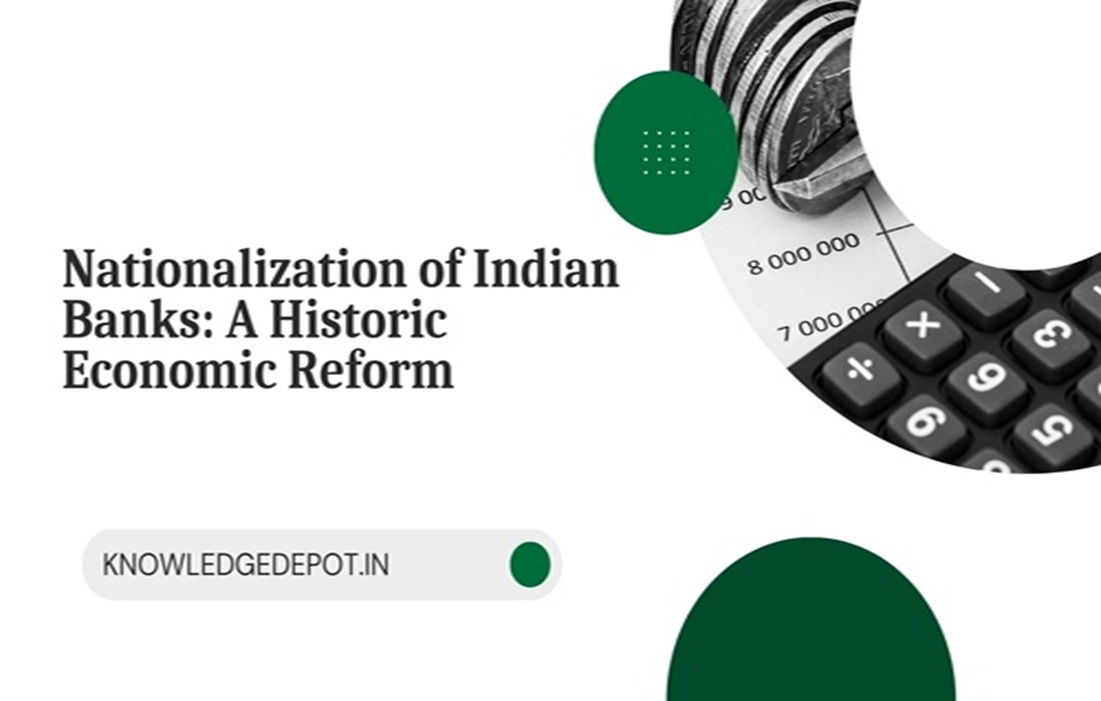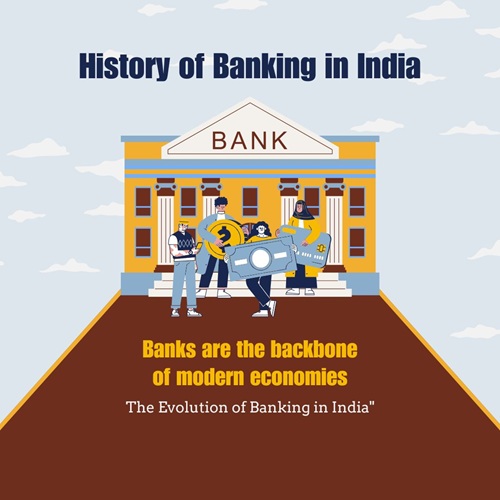The nationalization of Indian banks is one of the most significant economic reforms in the country’s history. This transformative event played a crucial role in reshaping India’s financial landscape, ensuring banking services reached rural and underprivileged sections of society. Before nationalization, banking was largely controlled by private entities, focusing primarily on urban and commercial sectors. The move to nationalize banks helped in promoting economic equality, improving financial inclusion, and strengthening the banking system.
In this article, we will explore the nationalization of banks in India, its history, objectives, impact, and future implications.
History of Nationalization of Banks in India
Pre-Nationalization Era
Before 1969, India’s banking sector was dominated by private banks, catering mostly to businesses and wealthy individuals. Rural areas, small industries, and farmers had limited access to banking services, leading to financial disparities across different regions.
- Imperial Bank of India (1921): The largest bank before nationalization, which later became the State Bank of India (SBI) in 1955.
- Bank Failures (1940s-50s): Many small banks collapsed due to poor management and economic instability.
- Need for Government Intervention: The growing economic gap between urban and rural areas necessitated state intervention.
First Phase of Nationalization (1969)
On July 19, 1969, the Government of India, under the leadership of Prime Minister Indira Gandhi, nationalized 14 major private banks. This decision aimed at ensuring banking services for all, especially rural and agricultural sectors.

List of Banks Nationalized in 1969:
- Central Bank of India
- Bank of India
- Punjab National Bank
- Canara Bank
- United Commercial Bank
- United Bank of India
- Dena Bank
- Syndicate Bank
- Allahabad Bank
- Indian Bank
- Bank of Baroda
- Union Bank of India
- Indian Overseas Bank
- Bank of Maharashtra
Second Phase of Nationalization (1980)
To further strengthen financial inclusion, the government nationalized six more banks in April 1980, bringing 91% of banking assets under government control.
Banks Nationalized in 1980:
- Andhra Bank
- Punjab & Sind Bank
- New Bank of India
- Vijaya Bank
- Oriental Bank of Commerce
- Corporation Bank
With these two phases, a total of 20 banks were nationalized, alongside the State Bank of India (SBI) and its subsidiaries (which were nationalized in 1955 and 1960).
Objectives of Nationalization
The Indian government had several key objectives behind nationalizing banks:
- Financial Inclusion: Extending banking services to rural and unbanked areas.
- Eliminating Monopoly: Reducing private sector dominance in banking.
- Agricultural & Industrial Growth: Providing credit to farmers, small businesses, and industries.
- Reduction in Economic Disparities: Bridging the gap between rich and poor through credit distribution.
- Stability in the Banking Sector: Preventing bank failures and financial crises.
- Increase in Government Revenue: Utilizing banking profits for national development.
Impact of Bank Nationalization
Positive Impacts
- Rural Expansion: Branches increased from 8,200 (1969) to 60,000+ (2020).
- Agriculture & SME Support: Priority sector lending became mandatory.
- Economic Growth: Banking sector played a key role in India’s economic rise.
- Employment Opportunities: Thousands of jobs created in public sector banks.
- Women Empowerment: Special schemes introduced for women entrepreneurs.
Challenges & Criticism
- Bureaucratic Control: Excessive government interference led to inefficiencies.
- Rise in Non-Performing Assets (NPAs): Poor loan recovery mechanisms.
- Lack of Innovation: Slow adoption of modern banking technologies.
- Corruption & Political Influence: Loan approvals often influenced by politics.
Post-Liberalization Banking Reforms (1991 Onwards)
With economic liberalization in 1991, India saw a shift towards privatization and competition:
- Entry of private sector banks like ICICI, HDFC, and Axis Bank.
- Introduction of Banking Sector Reforms to improve efficiency.
- Focus on technology adoption, including digital banking, ATMs, and online transactions.
- Merger of Public Sector Banks (2019-2020) to strengthen banking institutions.
Nationalization vs. Privatization: What’s Next?
In recent years, discussions about privatizing public sector banks have gained momentum. The government has hinted at selling stakes in weaker banks while retaining control over major ones.
Potential Benefits of Privatization:
- Increased efficiency and competitiveness.
- Better customer service due to reduced bureaucratic hurdles.
- Improved loan recovery and reduced NPAs.
Potential Risks:
- Risk of financial exclusion for rural and low-income groups.
- Potential job losses in the banking sector.
The future of India’s banking sector will likely see a balance between public and private participation, ensuring efficiency while maintaining financial inclusion.
Conclusion
The nationalization of banks in India was a landmark reform that transformed the country’s financial landscape. It played a crucial role in economic development, financial inclusion, and rural banking expansion. While challenges like rising NPAs and bureaucratic inefficiencies persist, the banking sector has adapted through modernization and policy reforms. With ongoing discussions on privatization, India must ensure a balanced banking ecosystem that serves both economic growth and social welfare.
Frequently Asked Questions
1. What is the nationalization of banks in India?
The nationalization of banks in India refers to the process where the Indian government took control of privately owned banks to ensure financial inclusion, economic stability, and equitable credit distribution. This happened in two phases, in 1969 and 1980.
2. Why were banks nationalized in India?
Banks were nationalized to promote financial inclusion, support agriculture and small industries, reduce economic disparities, and prevent monopolistic control over the banking sector by private entities.
3. Which banks were nationalized in 1969?
In 1969, 14 major banks were nationalized, including:
- Bank of India
- Punjab National Bank
- Canara Bank
- Allahabad Bank
- Union Bank of India
(See the full list in the article)
4. How did the nationalization of banks impact the Indian economy?
Nationalization led to an increase in rural banking, better credit distribution, and improved economic growth. However, it also led to bureaucratic inefficiencies and a rise in non-performing assets (NPAs).
5. What were the key objectives of bank nationalization?
The primary objectives included:
- Expanding banking services to rural areas
- Supporting agriculture and small industries
- Ensuring economic stability and financial security
- Reducing private sector dominance in banking
6. What challenges did nationalized banks face?
Some key challenges include:
- Rising NPAs due to poor loan recoveries
- Political interference in banking decisions
- Slow modernization and lack of innovation
- Operational inefficiencies in public sector banks
7. What reforms were introduced after bank nationalization?
Reforms in the 1991 economic liberalization allowed private and foreign banks to operate, introduced digital banking, and encouraged public sector bank mergers to strengthen the industry.
8. Is the Indian government planning to privatize nationalized banks?
Yes, in recent years, the government has considered privatizing weaker banks while retaining control over major public sector banks to ensure financial stability and inclusion.
9. How has digital banking impacted nationalized banks?
With advancements like UPI, internet banking, and mobile banking, nationalized banks are modernizing their services to compete with private and fintech companies.
10. What is the future of public sector banks in India?
The future will likely involve a balance between public and private participation, ensuring financial inclusion, digital innovation, and economic growth while minimizing inefficiencies.

